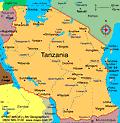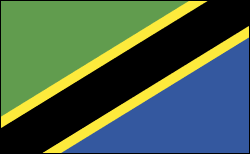GeographyTanzania is in East Africa on the Indian Ocean. To the north are Uganda and Kenya; to the west, Burundi, Rwanda, and Congo; and to the south, Mozambique, Zambia, and Malawi. Its area is three times that of New Mexico. Tanzania contains three of Africa's best-known lakes-Victoria in the north, Tanganyika in the west, and Nyasa in the south. Mount Kilimanjaro in the north, 19,340 ft (5,895 m), is the highest point on the continent. The island of Zanzibar is separated from the mainland by a 22-mile channel. GovernmentRepublic. HistoryArab traders first began to colonize the area in 700. Portuguese explorers reached the coastal regions in 1500 and held some control until the 17th century, when the sultan of Oman took power. With what are now Burundi and Rwanda, Tanganyika became the colony of German East Africa in 1885. After World War I, it was administered by Britain under a League of Nations mandate and later as a UN trust territory. Although not mentioned in old histories until the 12th century, Zanzibar was always believed to have had connections with southern Arabia. The Portuguese made it one of their tributaries in 1503 and later established a trading post, but they were driven from Oman by Arabs in 1698. Zanzibar was declared independent of Oman in 1861 and, in 1890, it became a British protectorate. Independence and a New NameTanganyika became independent on Dec. 9, 1961; Zanzibar on Dec. 10, 1963. On April 26, 1964, the two nations merged into the United Republic of Tanganyika and Zanzibar. The name was changed to Tanzania six months later. An invasion by Ugandan troops in Nov. 1978 was followed by a counterattack in Jan. 1979, in which 5,000 Tanzanian troops were joined by 3,000 Ugandan exiles opposed to President Idi Amin. Within a month, full-scale war developed. Tanzanian president Julius Nyerere kept troops in Uganda in open support of former Ugandan president Milton Obote, despite protests from opposition groups, until the national elections in Dec. 1980. In Nov. 1985, Nyerere stepped down as president. Ali Hassan Mwinyi, his vice president, succeeded him. Running unopposed, Mwinyi was elected president in October. Shortly thereafter plans were announced to study the benefits of instituting a multiparty democracy, and in Oct. 1995 the country's first multiparty elections since independence took place. A Bombing Tragedy and Government ScandalOn Aug. 7, 1998, the U.S. embassy in Dar es Salaam was bombed by terrorists, killing ten. The same day an even more devastating explosion destroyed the U.S. embassy in neighboring Kenya. President Benjamin William Mkapa (1995–2005) sought to increase economic productivity while dealing with serious pollution problems and deforestation. With more than one million people infected with HIV, AIDS care and prevention have been major public health issues. On foreign policy, Tanzania has taken a leading diplomatic role in East Africa, hosting peace talks for the factions fighting in neighboring Burundi. The UN International Criminal Tribunal for Rwanda (ICTR) is located in the town of Arusha. In Oct. 2000, Mkapa was easily reelected. In 2002, opposition leaders and foreign donors criticized the president's costly new $21 million personal jet. In 2005 presidential elections, foreign minister Jakaya Kikwete of the Chama Cha Mapinduzi (CCM) Party won with 80% of the vote. Prime Minister Lowassa resigned in February 2008 over a scandal involving an American energy company, Richmond Development, which was hired to provide Tanzania with generators to supply electricity to the country during a power shortage. The company never began the operation, yet Lowassa urged the government to renew the contract. Mizengo Pinda replaced Lowassa as prime minister. | ||||
Tanzania
Learn about the formation of Tanzania and the geography of East Africa by reading this country profile.
Infoplease
Provided by Infoplease—an authoritative, comprehensive reference website that offers an encyclopedia, a dictionary, an atlas, and several almanacs. Visit Infoplease.com to find more resources endorsed by teachers and librarians.









